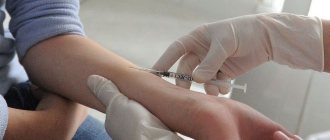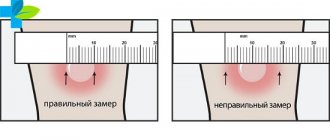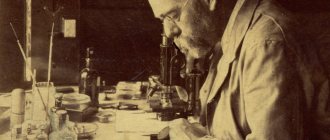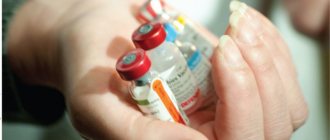Normal reaction to vaccination
It is important for parents to know which reactions are normal and which indicate complications.
About a month after the newborn is vaccinated, reactionary changes develop that are associated with the development of an immune response to the administration of the drug. For this, it is also worth clarifying how long the child’s symptoms persist and how the lump heals.
The vaccine reaction occurs due to the fact that inflammation begins at the injection site, which is accompanied by swelling of the skin and infiltration of the area with leukocyte cells. Externally, this can manifest itself as various symptoms that are characteristic of a vaccine reaction.
Parents should be able to distinguish normal signs of vaccination, which will go away on their own, from complications that require medical intervention. To do this, you need to know what the norm should look like and how long it lasts.
Physiological response to BCG
- Redness and swelling of the skin around the injection site. Skin hyperemia is considered a normal sign of a reaction to the vaccine; it can persist for a very long time - up to 1 year. The appearance of redness depends on the activity of the baby’s immune system. In some babies, the BCG becomes inflamed and turns red within a week; in others, the lump appears in the second or third month of life. This reaction does not require urgent medical intervention, but it is worth informing the pediatrician about this during a routine examination of the baby.
- An abscess or small pustule after administration of the drug. Some newborns develop a small abscess in response to the vaccine, with a white “head” in the center; the skin may become slightly purulent and swollen. The fact that BCG is festering causes panic in many parents, but there is no need to worry, such a reaction can also occur in healthy children. Suppuration is not associated with a violation of the injection technique or non-compliance with the rules of care for the vaccine.
- No skin symptoms. Quite often, parents turn to doctors about the fact that the child’s BCG does not fester and there are no skin changes within a year after vaccination for tuberculosis. There may be several reasons for this. If the drug was administered incorrectly, to too great a depth, then the compaction on the surface of the skin will not be noticeable. The lack of reaction may also be due to the fact that the child has not developed immunity to the bacterium due to his individual characteristics. This is quite dangerous for the baby, since as a result he is still susceptible to Mycobacterium tuberculosis. Therefore, if there is no reaction, it is necessary to undergo additional examination.
- Mild fever. A slight increase in the infant's body temperature is a normal response to the vaccine. Normally, it should not rise above 38 degrees. The fever usually goes away within 2-3 days. If it persists for a longer period, then you should suspect a pathological reaction and consult a doctor.
Healing standards
The listed consequences do not pose a threat to the baby’s health. If BCG has become festered, swollen or red, then there is no need to panic. Over time, they pass, leaving only a small scar on the child’s skin. The size of the scar should not exceed 10 mm. The duration of skin restoration depends on the individual characteristics of the child. On average, the vaccination site heals by 4 months of life; in some children, signs of healing of the BCG scar appear later.
In the first year of life, the baby should undergo regular medical examinations, including regarding the reaction to BCG. This will allow you to detect possible complications from BCG vaccination in time and take measures to eliminate them.
What should parents do?
If the BCG vaccine is red, doctors recommend:
- do not apply disinfectants (for example, iodine and brilliant green) to the seal;
- do not cut off the bubble that forms at the injection site, this may contribute to infection;
- do not bathe the child in the first days after vaccination, do not soap the vaccination site.
With the development of a hyperergic reaction, accompanied by severe redness and suppuration, the use of antihistamines and antibacterial agents may be required. They are selected taking into account the cause of the body’s inadequate reaction and the patient’s age.
Why is vaccination done?
One of the most important procedures that is done to a child as soon as he is born is the BCG vaccination. This injection is used for rapid immunization against a very severe and deadly disease, namely tuberculosis.
Tuberculosis is a highly contagious disease that affects organs such as the lungs, intestines, bones, and skin. Therefore, the first sign of infection is a prolonged cough, about a month, which is accompanied by sputum production. This cough cannot be treated with conventional methods. In the final stages, the disease is accompanied by hemoptysis, general exhaustion and damage to many organs.
Tuberculosis is most severe in newborns and children under one year of age. The percentage of infected children among all registered patients ranges from 7 to 8%.
Tuberculosis is especially dangerous for the youngest children, because in this case the disease very often also affects the brain, as well as other vital organs. Infection of an infant can occur through airborne droplets from any adult patient when he sneezes, coughs or talks in the presence of a child. The main danger is that many carriers of tuberculosis do not even realize that they have the disease, since they do not feel any symptoms. Few people become infected, only 5-15%.
The BCG vaccination procedure, or tuberculosis vaccination (BCG), is the main way to reduce the risk of contracting this dangerous disease.
The anti-tuberculosis vaccine contains microorganisms that cause tuberculosis, but it is impossible to get infected from them, and their use as a vaccination helps the human body develop strong immunity to the disease.
Normal condition after vaccination
BCG stands for bacillus Calmette-Guerin - this is the name of the tuberculosis bacillus that is part of the drug. The causative agent of the disease is quickly transmitted by airborne droplets, so anyone can become infected. The tuberculosis bacillus is in an inactive state in many people, but when factors are favorable for it, it begins to multiply. Most often, mild complications suffer from this, but severe complications without timely treatment lead to disruption of the functioning of other organs, and in particularly difficult cases, to death.
The development of the pathology is influenced by a weakened immune system, poor lifestyle, and constant stress—the only preventive measure is vaccination.
Vaccination cannot protect a person from mycobacteria, but it reduces serious complications of the disease. Children under two years of age have not developed a protective reaction of the body against infection, so the vaccine will help reduce the severity of the pathology. It will prevent the development of meningitis and other severe forms of pathological abnormalities that end in death.
BCG vaccination is carried out in the first week after birth, repeated revaccination is given to children seven years old.
Then the injection site may fester, although sometimes in children the wound does not fester, but a bubble with liquid forms; when it bursts, a scar is formed. If the BCG vaccination begins to fester and pus flows out of the wound, there is no need to panic, this is a normal reaction to the vaccination.
- apply ointment or cream;
- peck with a plaster;
- perform any manipulations;
- press, it is better to wipe the discharge with a napkin.
After healing, a scar with a diameter of no more than 8 mm is formed at the injection site. If there is no scar, this indicates the ineffectiveness of BCG vaccination. The child has not developed immunity to the tuberculosis pathogen, so a second vaccination is required.
Vaccination against tuberculosis, even if the scar begins to fester, is often painless, there are usually no serious consequences after BCG, and the baby tolerates it easily. But sometimes the body’s reaction is atypical, which makes parents worry. The most common consequences of BCG vaccination:
- The wound is red - the situation should not cause concern; redness is observed during suppuration and healing of the scar.
- The vaccine has rotted. This is a normal process if the skin around the purulent formation remains clean, without redness or swelling.
If a child experiences extensive swelling around the injection site, it is necessary to contact a pediatrician; the wound may become infected.
- The graft is inflamed, but the tissue around it is in a normal state, so there is no need to panic. If the inflammatory process spreads to the entire shoulder, a doctor's consultation is necessary.
- Rarely, after the injection, a slight body temperature may be observed, when the abscess begins to become inflamed, the temperature rises to 37.5 degrees. This is normal for babies; for older children, such a deviation is not typical and requires consultation with a pediatrician.
When observing such complications after vaccination, you also need to take into account the general condition of the child.
Why should you get the BCG vaccine?
Activation of tuberculosis occurs due to factors that negatively affect health, such as: poor nutrition, unsanitary conditions, alcohol and drug addiction, smoking, poor quality of life...
An increased number of mycobacteria in the body can also trigger the development of the disease.
The vaccine itself does not guarantee absolute immunity to tuberculosis. But the effectiveness of its use has already been proven.
In infected children under 2 years of age, tuberculosis occurs in a more weakened form and the development of meningitis tuberculosis is unlikely, and the risk of death is reduced.
In a weakened form, tuberculosis cures itself thanks to the immunity formed after vaccination.
BCG (Bacillus Calmette-Guerin) is produced from a weakened live vaccine of the tuberculosis bacillus, which is no longer dangerous to humans, since it was created in a special artificial environment.
Some mothers are afraid to consent to vaccination. But it's not right. BCG has been used for about a hundred years.
In the Russian Federation and CIS countries, the vaccine is included in the national vaccination calendar.
Due to the unfavorable epidemiological situation regarding tuberculosis in Russia, more than 70 thousand people become ill with it every year.
To treat tuberculosis, antibiotics prescribed by doctors are used, and they are taken for at least six months.
Antibiotic resistance in this disease develops very quickly.
So it is impossible to interrupt treatment or not completely follow the instructions.
If tuberculosis does not go away and complications appear, then solving these problems requires surgical intervention.
Contraindications and features of vaccination
In Russia, contraindications to BCG vaccination in newborns are as follows:
- The baby weighs less than 2.5 kg at birth.
- There is an immunodeficiency in the child or mother.
- Doctors diagnosed a generalized BCG infection to one of his closest relatives.
- Intrauterine infections, hemolytic disease, serious skin pathologies, and neurological problems have been recorded.
- Newborns have tumors of any size.
BCG should not be given to premature babies weighing less than 2 kg. For such babies, the maternity hospital provides the BCG-M vaccine, which contains half as much dangerous bacteria.
There are three reasons why BCG vaccination is delayed and can be carried out for the first time at 2, 3, 4 months, after a year and even later:
- The child's mother refused to vaccinate her child, and then changed her mind.
- Presence of temporary contraindications.
- Lack of vaccine in the maternity hospital.
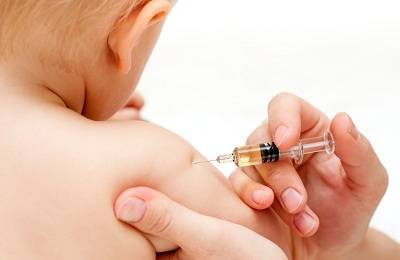
It is advisable that the clinic have a specialist specifically in administering this vaccine, in order to avoid the risk of developing a cold abscess due to medical error. It is not permissible to vaccinate in the room where blood tests are taken. If the risk of complications is still present, but doctors recommend vaccinating the newborn, the vaccine is administered in the hospital. On an outpatient basis, children who have not received the primary vaccine in the maternity hospital are vaccinated with BCG-M. This reduces the risk of complications, but this vaccination forms immunity against tuberculosis only for 7 years, while the BCG vaccine lasts for 15-20 years.
If the vaccination is given before 2 months, it is generally accepted that the child is not infected with tuberculosis. At the age of over 2 months, a Mantoux test must be done before vaccination to confirm the absence of the disease.
At 3 months the child should receive the first DTP vaccine, and at 4 months - the second. If the BCG vaccination has not been done by this time, then you should not combine vaccinations under any circumstances; such a load on the immune system will be unbearable. It is not recommended that vaccination occur during the hot summer, as the likelihood of complications increases significantly.
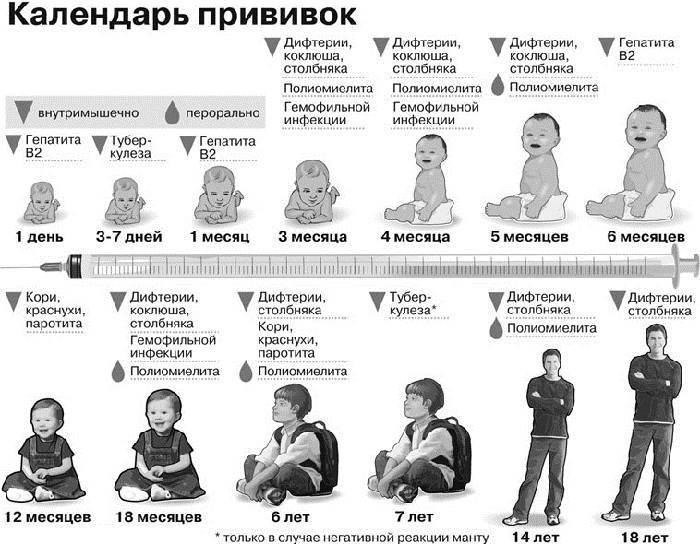
Vaccination calendar
If the primary BCG vaccination is done annually, then the child will first have to undergo a medical examination. Primary BCG vaccination after a year allows you to carefully prepare for the manipulation by first doing allergy tests for the components of the vaccine, then the child’s body will respond adequately to the BCG vaccination.
What to do if a bump and redness appears after vaccination: treatment
Meanwhile, parents mostly disagree with this harsh stance. They believe that health workers are obliged to warn about possible post-vaccination reactions and especially about the possible complications of certain vaccinations.
However, this is quite troublesome, and in general this issue is extremely difficult - discussions for and against vaccinations for children are very tough today! And doctors prefer not to touch upon this topic again: their job is to vaccinate the child whom you voluntarily brought to the clinic. And any reaction of the child’s body can then be described as “normal.” For the most severe cases, there is another protocol explanation - the individual reaction of the body, which cannot be predicted.
In general, in order not to look for those to blame later, it is better to monitor the quality of the vaccine offered at the site in advance and buy a higher-quality analogue yourself if the need arises. In addition, the child must be prepared for the procedure: a few days before and after vaccination, all potentially negative effects, both physiological and psycho-emotional, must be minimized. It is very undesirable for a vaccinated child to get sick, because his immune system is now weakened. Do not forget also that there are a number of contraindications to vaccination: each time you should make sure that the child does not have any of them.
If the baby has a local or general reaction to vaccination once, then from now on 3 days before the administration of the drug and for 3 days after that it is necessary to give him an antihistamine, which is selected individually by a specialist.
This is about prevention. How to treat redness and thickening after vaccination in a child?
Ideally, contact your pediatrician. He will assess the severity of the reaction and give his recommendations. Doctors often warn mothers that nothing can be done to treat such inflammations! Iodine mesh, compresses, ointments - all this can only worsen the child’s condition. In other cases, nurses recommend the same iodine net, compresses from cabbage leaves or vodka. By the way, about vodka: the method is quite effective, and sometimes even surgeons recommend it when mothers turn to them with similar complaints. You need to soak gauze in the drink and apply compresses to the inflamed area. After 2-3 hours, this application is removed, and after a 2-3 hour break, it is applied again. So throughout the day.
Surgeons also prescribe treating the lump with ointments (Traumel, Troxevasin), Novocaine or Magnesia lotions, Dimexide and Chlorhexidine.
However, even without any treatment, the inflammatory process will gradually decline, pediatricians say. Normally, everything goes away in 2-3 days without any treatment, but sometimes you need to be more patient.
You should consult a doctor only if over time the lump does not decrease in size (and perhaps even increases, exceeding 6-8 cm in diameter) in size or if suppuration begins at the injection site (in this case, you need to go to the hospital immediately! ).
Especially for nashidetki.net - Larisa Nezabudkina
Pathological reaction to BCG
BCG vaccination is dangerous due to a number of serious complications that can occur in a child. The vaccination site may become severely inflamed or fester, and the child’s temperature usually rises to febrile levels (above 38 degrees). Such changes are a reason to consult a doctor to prevent the vaccine from spreading mycobacteria throughout the child’s body.
Many parents do not know what it is - BCG - and what its clinical picture looks like. The symptoms of this disease are as follows:
- Lymphadenitis is inflammation of nearby lymph nodes, accompanied by their enlargement;
- Spread of the abscess over large areas (cold abscess);
- Skin ulcer;
- A colloidal scar is a pathological compaction at the grafting site, covered with swollen red skin.
In rare cases, more severe complications may occur after BCG. These include primarily osteitis and osteomyelitis. These processes occur if the bacteria contained in the vaccine are not restrained by the immune system and enter the child’s bones. This leads to the bone marrow substance becoming rotted.
Another serious complication of vaccination may be a generalized BCG infection. This condition is characterized by the spread of pathogenic microorganisms throughout the infant's body. The occurrence of BCGitis in children requires emergency medical intervention, since its progression can lead to serious consequences.
Common pathological processes during vaccination are currently reduced to a minimum. They occur in very rare cases when contraindications to vaccination were ignored. Therefore, there is no need to be afraid of vaccination and refuse it, as this will provide the child with immunity to tuberculosis.
What complications cause concern and how to avoid them?
In rare cases, serious complications are possible after BCG, which cause significant disruption to the baby’s health and require adequate treatment. Severe consequences are diagnosed in children with congenital immunodeficiency.
Incorrect technique for performing the procedure also has a negative impact on the child. There are a number of complications after vaccination:
- a cold abscess is observed when the injection is not intradermal, but subcutaneous;
- the formation of an ulcer at the injection site occurs due to increased sensitivity to the active substances of the drug;
- lymph nodes can become inflamed when mycobacteria enter the lymph nodes, the situation requires timely treatment when their size exceeds 1 cm in diameter;
- a keloid scar is caused by a skin reaction to the drug; such a deviation prohibits revaccination at the age of seven;
- generalized BCG infection is a serious complication that develops due to immune abnormalities in an infant.
These consequences are diagnosed extremely rarely, so there is no need to refuse vaccination, it is the only preventive method for preventing tuberculosis. If serious changes in the skin are detected, it is necessary to show the child to a specialist, and an experienced pediatrician will prescribe the correct treatment.
Older children should be re-vaccinated after being examined by a doctor; several vaccinations cannot be given at the same time; the break is one month.
Contraindications
Complications that arise can also be caused by the fact that contraindications were not taken into account during vaccination.
It is prohibited to administer live organisms to newborns if the following signs are observed:
- the child weighs less than two kilograms;
- the baby became infected in the womb;
- the mother was diagnosed with HIV infection;
- immunodeficiency of any nature is observed;
- there are lesions of the central nervous system;
- purulent, inflammatory processes on the skin.
These factors prevent vaccination of young children. Vaccination does not completely protect against tuberculosis; it helps the body develop immunity against pathogenic microbacteria. The effect of the drug lasts about 5–7 years, then you need to give a second injection. Before vaccination, children must undergo a Mantoux test.
For adults and older children, the following contraindications exist:
- positive Mantoux test result;
- severe complications during the first administration of the drug;
- tuberculosis disease or infection;
- oncological diseases;
- pregnancy;
- colds or other chronic diseases during exacerbation;
- allergic reactions.
Recommendations from experts
After vaccination, the child can be bathed in boiled water; before this, the bath can be treated with potassium permanganate or another antiseptic. During water procedures, you should not rub the injection site with a washcloth, steam it, or rub it with a towel.
Until the wound is completely healed, iron the baby's clothes on both sides and put them on carefully so as not to injure this area of skin. During the day it is better not to leave the wound open, cover it with a light blouse
The healing process should occur naturally, without additional manipulation.
It is necessary to protect the child from contact with sick people and not to visit public places. If the baby gets sick during this period, recovery will take a long time. But walks in the fresh air are acceptable if the child looks healthy and feels well.
You must also adhere to the following recommendations:
- Before the procedure, conduct a test for an allergic reaction and compatibility of the active substance with the body;
- after an injection, you should not lubricate the wound with ointments or antiseptics;
- during suppuration, it is forbidden to make an iodine mesh or squeeze out liquid or pus from the wound;
- make sure that the child does not scratch the injection site;
- Before and after the procedure, you cannot change your diet; this will allow you to determine the cause of the allergy.
If any complications occur, you should consult a doctor. The vaccination procedure will not completely protect against the disease, but it will help develop immunity against the causative agent of tuberculosis and prevent the development of serious complications in the event of contracting the disease.
Contraindications to the vaccine
The development of various kinds of complications may be the result of contraindications in the child.
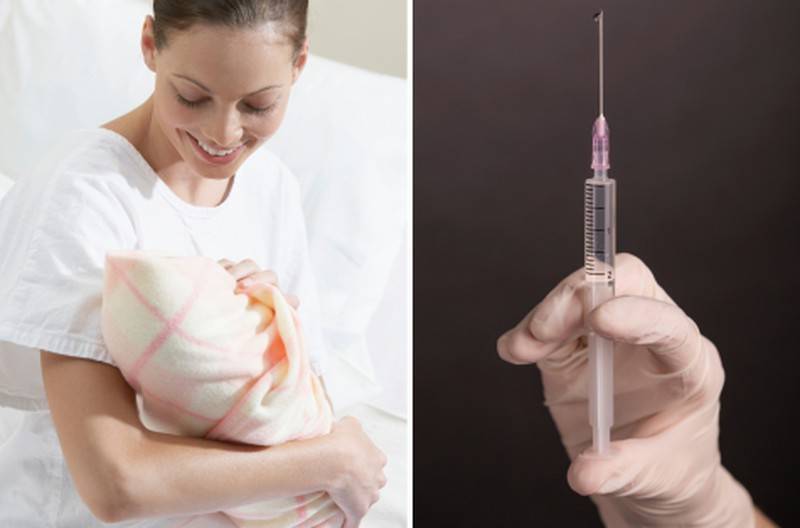
The ban on the introduction of living organisms to newborn children is based on the presence of one of the following factors:
- low baby weight;
- intrauterine infection with pathogenic microorganisms;
- diagnosis of HIV infection in the mother;
- immunodeficiencies of various etiologies;
- diseases of the central nervous system;
- the presence of inflammatory processes in the body;
- active stage of the disease after diagnosis using x-ray photos.
These contraindications are absolute. If they are present, the BCG vaccine is completely prohibited. Vaccination will not provide complete protection against tuberculosis, but it can help develop immune defenses against bacterial agents.
The duration of the drug is on average 7 years. After this period has expired, revaccination must be carried out. Before this, a mandatory Mantoux test is performed.
Before administering the BCG vaccine, you must undergo a full examination by specialized doctors. This will help reduce the likelihood of complications and also protect the child’s health.
If BCG is inflamed. Signs and causes
Inflammation at the injection site of the BCG vaccine is completely normal. This is how the body reacts to the administered drug. However, if the inflammation is localized not only in the place where the needle was inserted, but spreads to nearby areas of the skin, then this is already a serious cause for concern.
The most common reactions include:
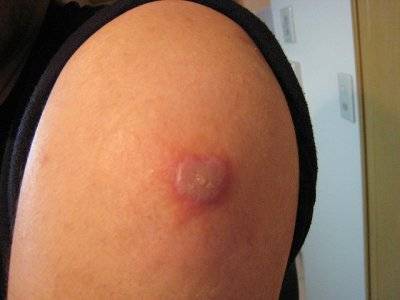
- Redness of the injection site. Redness in the injection area is normal, so there is no need to worry. However, if the redness spreads to other areas of the skin, then you need to consult a specialist.
- Presence of pus. Often a small abscess filled with pus forms at the injection site. This is normal, but if there is swelling and severe redness around the abscess, then it is quite possible that an infection has gotten inside and the BCG has become inflamed. Parents should carefully examine this place in order to notice these symptoms in time.
- Swelling of the vaccination site. The presence of swelling after the injection should not be a cause for concern. As a rule, the swelling disappears after a few hours. A cause for concern is the presence of edema during the post-vaccination reaction, that is, when suppuration and redness appear. Here you need to consult a phthisiatrician.
- In some cases, an increase in body temperature is observed. Although this is a rare occurrence, it should not cause concern for parents of children under two years of age. If this symptom appears in children under 7 years of age, or in adults, then you need to consult a doctor.
The vaccine may become inflamed approximately 1.5 months after vaccination. Such a delayed reaction is normal, so you need to take this process calmly. The injection site may look like a red pimple or a small abscess. If the surrounding tissues are in normal condition, then there is no reason to see a doctor. If the inflammatory process spreads further, or if the graft begins to become inflamed after a year, then most likely there is a complication after the procedure.
Why can BCG become inflamed immediately or after some time?
There are a number of reasons that cause inflammation after the procedure. It is worth understanding that this is no longer a natural reaction of the body, but a consequence of these factors:
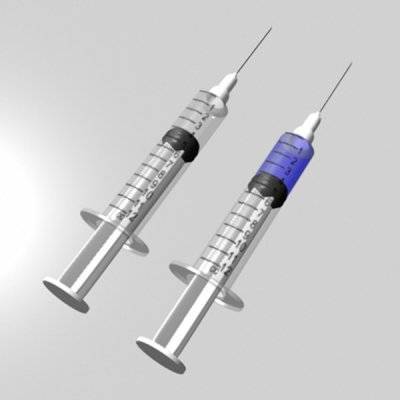
- Vaccination if a child (or an adult) has contraindications to this.
- Failure to comply with vaccine administration technology. The procedure should only be performed by experienced professionals, and this function should not be delegated to trainees or medical professionals with insufficient experience.
- The vaccine may become inflamed due to exceeding the permissible dose of the administered drug. This is also a consequence of the inexperience of medical workers.
- The drug turns out to be of inadequate quality. The reason for this may be the development of osteomyelitis.
- Individual characteristics of the body. Each child (and adult) is individual, so it is difficult to predict the reaction of his body to a particular medical procedure. In some children, the formation and healing of the pustule occurs completely normally, while in some it may become inflamed, etc.
When should BCG not be given to a child or an adult?
Ignoring contraindications can lead to the appearance of an atypical inflammatory process after an injection. To avoid this, a medical professional must know the list of factors that are a contraindication to the administration of the BCG vaccine:
- Underweight newborn baby. According to the rules, its weight must exceed 2.5 kg.
- Presence of chronic diseases. If a child has suffered an intrauterine infection, if he suffers from hemolytic disease, various neurological disorders, then he must first deal with these problems. Vaccination is possible only after the child’s condition has completely stabilized.
- The presence of complications after BCG in the parents and immediate family of the child.
- Maternal immunodeficiency virus.
- Positive Mantoux test.
Only healthy children are vaccinated, therefore the presence of the disease itself, i.e. tuberculosis, is a contraindication to the procedure.
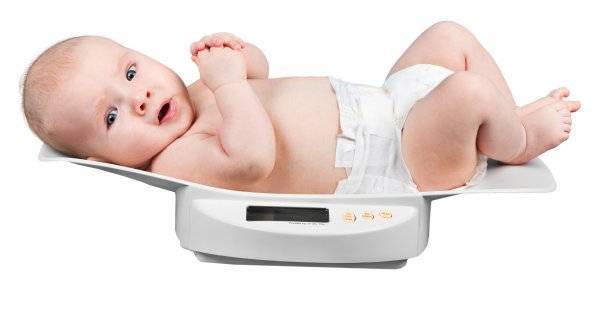
Photo 2: The hospital checks the baby's weight to see if it is normal.
BCG vaccination - consequences
Today, the issue of vaccinating children is very acute. More and more mothers are abandoning the standard vaccination schedule and prefer individual selection or complete refusal. In maternity hospitals, the child is given his first vaccination - BCG. It is this vaccination that raises the most questions and concerns among mothers. In this article we will analyze the reactions and possible complications of BCG.
Reaction to BCG in newborns
It is important to remember that this vaccine belongs to the group of delayed ones: the reaction does not occur in a couple of hours, but some time after the injection. This does not mean that there was something wrong with the vaccine, this is exactly how the process should go.
As for the consequences of BCG vaccination, the following possible reactions occur.
- The BCG vaccine turned red. If you notice a reddish tint to the skin around the injection and slight suppuration, there is no cause for concern. In this case, the redness should only be in the injection area and not spread to other tissues. It happens that the BCG vaccine turns red and a scar forms at the injection site. This is also the norm, this is how the skin reacted to the drug.
- BCG festers. Normally, the injection site should have slight suppuration with a crust in the middle. At the same time, the nearby tissues remain in normal condition. If there is redness around the pustule, you should consult a specialist, as there is a possibility of infectious infection.
- BCG is inflamed. If the tissue around the injection site is normal, and the injection site itself takes the form of an abscess, a bubble with liquid, or is inflamed, there is no need to worry. If there is swelling or inflammation behind the injection area, then you need to contact your pediatrician.
- The BCG reaction can be in the form of fever or itching in the injection area.
Complications after BCG vaccination
It is immediately worth noting that the number of cases of complications after BCG relative to the number of vaccinated children is low. And most often these children include infants with immunodeficiency. All problems arise either from a low-quality vaccine or from its incorrect administration.
The consequences of BCG vaccination, which are a condition for children when there is a serious threat to health, include the following:
- a cold abscess may develop when the drug is administered subcutaneously rather than intradermally;
- extensive ulcer (occurs with high sensitivity to the components of the drug);
- osteitis or generalized BCG infection (occurs in cases where the child has serious immune disorders).
Whether or not to get this vaccination is up to the mother of the baby to decide. But do not forget to consider the possible consequences of refusing the vaccine.
| Many mothers who decide to routinely vaccinate their child are faced with a fairly wide variety of vaccinations. In our article we will tell you more about the ADSM vaccination. | What vaccinations are given in the maternity hospital? According to the vaccination calendar, the first scheduled vaccinations for newborns are given immediately in the maternity hospital. In our article we will tell you which vaccinations you may be offered and whether you can refuse them. |
| Parents deciding to routinely vaccinate their children are faced with the question of choosing vaccinations. In our article we will tell you in more detail about the Infanrix Hexa vaccine and its features. | Routine vaccination of children raises a lot of questions among parents, including those related to the choice of vaccinations. In our article we will talk in more detail about the vaccine against Haemophilus influenzae, which is called Hiberix. |
Possible reactions to the BCG vaccine
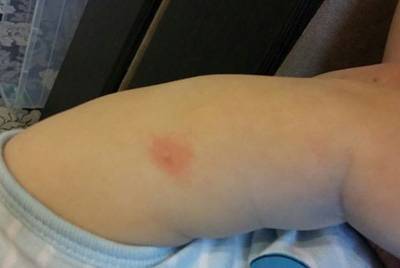
Many parents consider any body response to a vaccine to be abnormal. This opinion is incorrect, since vaccine reactions are an integral part of the vaccination process.
Normally, after the vaccine is administered, a papule no larger than 1 centimeter in size forms at the injection site. This means that the vaccination was successful and the papule will resolve on its own in half an hour.
Other body reactions may also occur:
- Redness. If the vaccination site turns red and a small abscess has formed in it, do not rush to worry, such a reaction is not considered a pathology. This means that the injection site heals, and the body carries out a natural fight against foreign bodies and develops immunity. Sometimes a dense scar forms at the site of vaccine administration, extending beyond the wound, and the skin turns red and swells slightly.
This reaction is also normal and indicates that the skin has reacted to the vaccine. In addition, the redness of the graft may continue for a whole year. For some this happens within a few days, for some by the end of the month, and for others only after six months. In this case, there is no need to panic and run to consult a doctor, but you need to report redness during a routine examination.
- Swelling. After receiving the vaccine, the injection site may swell slightly. This reaction does not last long - 2-3 days and, as a rule, goes away on its own. In this case, there is no reason to worry. After a month and a half, suppuration begins and a red pimple appears at the site of vaccination, ending with the formation of a scar.
Important! Redness, swelling and suppuration should not spread to the tissue surrounding the graft. If the reaction becomes extensive, you should show the cause of concern to a phthisiatrician, t.
It is possible that the wound may become infected and require treatment.
- Abscess. Often, parents begin to worry if the BCG vaccine turns red and an abscess occurs. In the normal course of the reaction, after a few months an abscess appears at the injection site, which gradually forms a crust. If suppuration of the wound occurs several times, a diagnosis of BCGitis is made, and the doctor prescribes appropriate treatment.
Important! During the healing period, the grafting site is vulnerable to infection. You can’t leave the wound open, much less tear off the scab yourself.
Over time, it will go away on its own, and the grafting site will heal.
- Itching. If the BCG vaccine itches, there is no need to sound the alarm. Itching in this case occurs due to healing and restoration of the skin. However, you cannot rub or comb it; it is best to put a gauze napkin or put on gloves on the child’s vaccination.
- Temperature. If after administration of the vaccine the temperature rises no higher than 38 degrees and lasts for 2-3 days, there is no cause for concern. This is a normal reaction of the body to the introduction of foreign bacteria.
If your child has a high fever for more than 3 days, seek medical help immediately.
- Enlarged lymph nodes. The permissible enlargement of lymph nodes after administration of the vaccine is 1 cm. This reaction indicates the response of the body’s immune system to the vaccine. If the lymph nodes have seriously increased in size, this is a reason to consult a doctor, since this may be a sign of microbacteria entering them, which requires prompt medical intervention to avoid complications.
You should not burn the vaccination site with alcohol-containing substances, smear it with healing creams or seal it before swimming. The healing process of the vaccination site does not require external interventions.
Complications
Complications after BCG can occur even in those people for whom this vaccination was not prohibited for any reason. Regional lymphadenitis is considered a normal phenomenon: the lymph node located near the site of vaccine administration increases to 1 cm in diameter, a compaction appears at the site of vaccination, and a papule is formed that remains for up to 2 weeks (after which a small scar appears in its place). Complications often develop when instructions are not followed, indications for vaccination are ignored, etc.
Temperature
An increase in temperature after BCG vaccination is not considered a pathological manifestation if it goes away on the first day. It may appear the next day or within a few hours after the drug is administered to the body. The use of medications is necessary only when the indicator rises to 38°C or more. If the temperature remains elevated for more than 2 days, it is recommended to consult a doctor. At home, to combat this side effect, drink plenty of fluids.
If there is no temperature at all after BCG, the reaction is not considered good: there is a high probability that the child has not developed immunity to Koch’s bacillus.
Why does the vaccination site fester?
Suppuration can occur if the injection technique is incorrect. If the BCG vaccination festers, it is necessary to urgently begin treatment: purulent processes can spread. Often such a reaction develops due to a cold abscess. If such a complication of BCG vaccination occurs, you need to take action as soon as possible and consult a doctor.
Cold abscesses
Cold abscess after BCG is a side effect in which an abscess occurs, there are no other pronounced manifestations (temperature, redness, swelling, symptoms of intoxication). The complication does not immediately manifest itself aggressively; At first, you can only see a small wound at the injection site. Externally, it can manifest itself differently in each person, depending on the individual characteristics of the body.
Within 2-3 days after administration, you can observe that the BCG vaccination has turned red and slightly swollen. Then, however, such manifestations disappear, and within 1-1.5 months there are no manifestations of the pathological process. Then a papule appears, quickly turning into an abscess. It can break out in different ways. Normally, the neoplasm looks like a pimple, a capsule with clearly visible purulent contents. It reaches 1-1.2 cm in diameter.
For small suppurations, there is no need to worry. Their occurrence is considered a variant of the norm, a natural reaction of the body. If the size of the abscess is too large, the skin around the BCG injection site turns red, secondary infection or mechanical damage caused by improper insertion of the needle is possible. In such a situation, you will need the help of a specialist. BCG does not often fester; A similar complication is more often observed during the first vaccination than during revaccination.
Other
Lymphadenitis is considered normal if the diameter of the lymph node does not exceed 1 cm. In situations where, due to inflammation, the size is too large, you will have to consult a doctor. Sometimes surgery may be required.
Sometimes after BCG the consequences appear in the form of an ulcer that occurs at the site of insertion of the syringe. Keloids (areas of scar tissue that grow in the area where the vaccine was administered) also appear.
A rarer side effect of BCG is osteitis, an inflammatory process that develops in bone tissue. Bone tuberculosis is considered a more dangerous pathology. The pathology manifests itself 1-3 years after the introduction of weakened microorganisms and is difficult to treat.
After vaccination with BCG, an allergic reaction may result. A skin rash appears, and general symptoms of intoxication are noted (weakness, nausea, loss of appetite, increased fatigue; young children can become capricious and whiny). If a similar reaction to BCG was treated in an infant, at an older age they refuse the vaccine.
BCGit is also rarely observed.
Manifestations of erythema nodosum are possible. This pathology is characterized by the appearance of painful, swollen nodes on the body, a general asthenic state, and an increase in body temperature (low-grade fever is more often observed, and high temperature is less common).
Granuloma annulare is also manifested by the appearance of nodes. They are small in size (about 3-4 mm in diameter), high density, and often merge into rings.
Possible development of lupus. A specific rash appears on the limbs and face. In addition, there are joint pains and a general deterioration in well-being. Anemia, leukopenia, and thrombocytopenia develop.
Why does swelling occur at the injection site?
The human immune system is responsible for many small tasks that boil down to a single goal - protection against all diseases. In the first year of life, the child is protected by powerful antibodies received from the mother. Later, breast milk or special formulas strengthen the immune system. Their task is to form a good own immunity to most diseases. Additionally, vaccinations help them.
It is logical that the introduction of even weakened viruses or their specific cells will cause certain reactions. Most of them do not last long and go away within 2-3 days. These include: fever, nausea and diarrhea, a mild form of the disease, for which a vaccine was given, and some local reactions.
If a child's arm or leg is swollen after vaccination, then in most cases this is a normal reaction of the body. There can be no complications with a small tumor. Doctors distinguish 3 types of post-vaccination reactions: complications, moderate and mild.
The last two types are characterized by minor side effects, which are considered normal. Most often, after vaccination, the child’s injection site swells, weakness and drowsiness, and high fever appear.
The tumor is within normal limits
If after vaccination the child’s injection site is swollen, induration and redness appear, this will last on average 1-2 days. In this case, the reaction is considered normal. Statistically, lumps and redness appear in every 4 vaccinated children. Subsequent revaccination can enhance the effect, since during this period the final formation of immunity occurs.
After the DPT vaccination, the child's arm or leg in the area of the injection swells, and the lump can reach 8 cm in diameter. And all this is also considered the norm. If the lump becomes larger than 8 cm, then this indicates non-compliance with the doctor’s requirements, but usually does not pose a danger to the baby. Even a large tumor goes away on its own within a maximum of 5 days. After a BCG vaccination, a swollen lump in a child may become crusty, which is also considered normal.
The only time when a tumor is not considered normal is when additional symptoms occur:
- the appearance of suppuration;
- severe itching, irritability and crying of the child;
- rapidly developing swelling of nearby tissues;
- the appearance of a rash and other unpleasant reactions.
If the temperature rises from 38.5 degrees and persists for 2 days, you should consult a doctor. Such symptoms indicate the presence of an allergic reaction.



